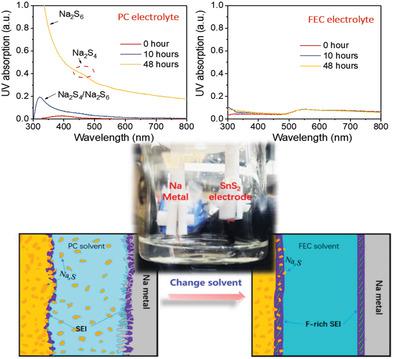当前位置:
X-MOL 学术
›
Small Methods
›
论文详情
Our official English website, www.x-mol.net, welcomes your
feedback! (Note: you will need to create a separate account there.)
Revealing the Critical Factor in Metal Sulfide Anode Performance in Sodium‐Ion Batteries: An Investigation of Polysulfide Shuttling Issues
Small Methods ( IF 10.7 ) Pub Date : 2019-11-11 , DOI: 10.1002/smtd.201900673 Mingxiang Hu 1, 2 , Zhengyu Ju 1 , Zhongchao Bai 1 , Kang Yu 1 , Zhiwei Fang 1 , Ruitao Lv 2 , Guihua Yu 1
Small Methods ( IF 10.7 ) Pub Date : 2019-11-11 , DOI: 10.1002/smtd.201900673 Mingxiang Hu 1, 2 , Zhengyu Ju 1 , Zhongchao Bai 1 , Kang Yu 1 , Zhiwei Fang 1 , Ruitao Lv 2 , Guihua Yu 1
Affiliation

|
Metal sulfides are a class of promising anodes for sodium‐ion batteries with high theoretical capacities. However, the properties of intrinsic metal sulfide anodes usually decay rapidly at initial cycling of batteries. Previously, it was believed that the low conductivity and volume expansion of metal sulfides lead to the poor performance. Here, using in situ batteries followed by the assistance of spectral analysis, it is shown that the polysulfide shuttling effect is one of the crucial factors for the degradation of metal sulfide anodes beyond traditional consensus of low conductivity and volume expansion. Furthermore, a novel strategy by controlling the dissolution of sodium polysulfides in selected electrolyte is proposed to enable intrinsic metal sulfides to work stably in polysulfide‐insoluble fluoroethylene carbonate electrolyte, which would decay fast in polysulfide‐soluble propylene carbonate electrolyte. This work has deepened the understanding of electrochemical reaction mechanisms of metal sulfide anodes and expanded the strategies to optimize the electrochemical performance of metal sulfides anodes.
中文翻译:

揭示钠离子电池中金属硫化物阳极性能的关键因素:多硫化物穿梭问题的研究
金属硫化物是钠离子电池的一类有前途的阳极,具有很高的理论容量。然而,固有的金属硫化物阳极的性能通常在电池的初始循环时迅速衰减。以前,人们认为金属硫化物的低电导率和体积膨胀导致较差的性能。在这里,使用原位电池并辅之以频谱分析,结果表明,多硫化物的穿梭效应是金属硫化物阳极降解的关键因素之一,这超出了传统的低电导率和体积膨胀的共识。此外,提出了一种通过控制多硫化钠在所选电解质中的溶解的新策略,以使本征金属硫化物在不溶于多硫化物的氟代碳酸亚乙酯电解质中稳定运行,在多硫化物可溶的碳酸亚丙酯电解质中会迅速衰减。这项工作加深了对金属硫化物阳极电化学反应机理的理解,并扩展了优化金属硫化物阳极电化学性能的策略。
更新日期:2019-11-11
中文翻译:

揭示钠离子电池中金属硫化物阳极性能的关键因素:多硫化物穿梭问题的研究
金属硫化物是钠离子电池的一类有前途的阳极,具有很高的理论容量。然而,固有的金属硫化物阳极的性能通常在电池的初始循环时迅速衰减。以前,人们认为金属硫化物的低电导率和体积膨胀导致较差的性能。在这里,使用原位电池并辅之以频谱分析,结果表明,多硫化物的穿梭效应是金属硫化物阳极降解的关键因素之一,这超出了传统的低电导率和体积膨胀的共识。此外,提出了一种通过控制多硫化钠在所选电解质中的溶解的新策略,以使本征金属硫化物在不溶于多硫化物的氟代碳酸亚乙酯电解质中稳定运行,在多硫化物可溶的碳酸亚丙酯电解质中会迅速衰减。这项工作加深了对金属硫化物阳极电化学反应机理的理解,并扩展了优化金属硫化物阳极电化学性能的策略。











































 京公网安备 11010802027423号
京公网安备 11010802027423号